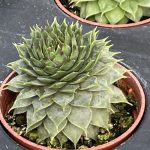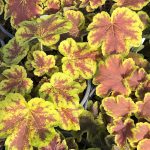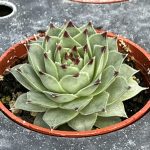Iris confusa, Bamboo Iris Chengdu
Price range: $9.99 through $19.99
Discount per quantity
| Quantity | 3 - 8 | 9 - 14 | 15+ |
|---|---|---|---|
| Price | Price range: $9.69 through $19.39 | Price range: $9.39 through $18.79 | Price range: $8.99 through $17.99 |
| % Discount | 3% | 6% | 10% |
Description
Iris confusa: Bamboo Iris of Chengdu
Iris confusa, often called the Bamboo Iris, is one of the most graceful and unusual members of the iris family. Native to the misty forests of southwestern China, especially around Chengdu, this plant blends elegance with resilience. Its lush fans of bamboo-like leaves and delicate spring flowers make it a remarkable choice for gardeners who want something exotic yet easy to grow.
Origins and Cultural Roots
Iris confusa belongs to the Iridaceae family and is closely related to the better-known crested irises (Iris japonica and Iris wattii). It originates from Sichuan and Yunnan provinces, where it grows along woodland edges, slopes, and shaded ravines. In Chengdu, the plant’s natural habitat is cool and damp, with dappled light filtering through forest canopies.
The name “Bamboo Iris” comes from its unusual leaf habit. Instead of forming typical iris fans at ground level, the leaves rise from tall, cane-like stems that resemble bamboo. This growth style gives the plant a lush, tropical look.
Appearance and Unique Features
- Stems: Upright, jointed stems up to 2–3 feet tall, resembling slender bamboo canes.
- Leaves: Broad, lance-shaped leaves that grow at the tops of the stems, forming rosettes of fresh green foliage.
- Flowers: Blooms appear in clusters in late spring to early summer. Each flower is about 2–3 inches wide, white with violet or yellow crests and soft purple flecks.
- Growth Habit: Spreads by rhizomes to form attractive clumps that create a natural woodland groundcover.
Growing Conditions
Light
Iris confusa prefers partial shade, much like its woodland home. It thrives under tall trees or on the east side of buildings where it receives soft morning sun. In hotter climates, protection from harsh afternoon sun prevents leaf scorch.
Soil
Rich, well-draining soil with ample organic matter is ideal. A woodland-style soil mix with leaf mold or compost mimics its natural habitat. It tolerates slightly acidic to neutral soil conditions.
Water
Consistent moisture is key. The plant appreciates evenly damp soil, especially during active growth in spring and summer. However, avoid waterlogging, which can lead to root rot.
Temperature
Hardy to USDA zones 7–10. In colder zones, it benefits from mulch in winter or can be grown in containers that are brought indoors during freezing weather.
Planting and Care
- Planting Depth: Set rhizomes just below the soil surface. Space plants 12–18 inches apart to allow clump expansion.
- Mulching: A layer of leaf mulch or compost preserves soil moisture and keeps roots cool.
- Feeding: Apply a balanced, slow-release fertilizer in early spring to promote lush foliage and abundant blooms.
- Pruning: Remove spent flower stalks and trim back any damaged leaves to maintain tidiness.
- Division: Divide clumps every 3–4 years in early spring or late summer to rejuvenate growth and prevent overcrowding.
Propagation
Iris confusa is easy to propagate:
- Division: Separate rhizomes with leafy stems and replant immediately. This is the most common method.
- Stem Cuttings: Leafy stems can root at nodes if placed in moist soil or water.
- Seeds: Possible but slow; seedlings take several years to reach flowering size.
Design and Landscape Uses
The Bamboo Iris shines in shaded gardens, especially woodland or Asian-inspired landscapes. Its tall leafy stems add vertical texture, while the spring blooms bring soft elegance.
- Understory Planting: Combine with ferns, hostas, or hellebores for layered woodland beds.
- Container Gardens: Works beautifully in large pots for shaded patios.
- Mass Plantings: Creates a lush carpet under deciduous trees when planted in drifts.
- Exotic Borders: Adds tropical flair without the fuss of true bamboo.
Seasonal Interest
- Spring: Showy white and purple flowers rise above leafy stems.
- Summer: Foliage remains fresh and architectural, creating a lush canopy.
- Fall: Leaves stay green in mild climates; older leaves may be trimmed to refresh growth.
- Winter: Evergreen in warm zones; semi-evergreen or dormant in colder areas.
Common Problems and Solutions
- Leaf Burn: Caused by excessive sun or drought. Move to a shadier spot and maintain soil moisture.
- Root Rot: Prevent by ensuring soil drains well; avoid standing water.
- Pests: Rarely troubled, though snails or slugs may chew foliage in damp conditions.
Companion Plants
Pairing Iris confusa with plants that enjoy similar conditions creates harmony in the garden:
- Ferns: Enhance the woodland feel with delicate fronds.
- Hostas: Bold leaves contrast beautifully with iris foliage.
- Astilbes: Add feathery summer blooms and texture.
- Heucheras: Provide colorful foliage for year-round interest.
Why Gardeners Love Iris confusa
This plant appeals to gardeners for many reasons:
- Low Maintenance: Once established, it needs little care beyond occasional watering and division.
- Unique Structure: The bamboo-like stems create a look unlike any other iris.
- Shade Tolerance: Perfect for those tricky garden spots with dappled or full shade.
- Long-Lived: Thrives for years when happy, forming impressive clumps.
- Exotic Flowers: Delicate crested blooms provide early-season color and charm.
A Plant with Story and Charm
In Chengdu and throughout Sichuan, Iris confusa grows quietly in woodland edges and temple gardens. It represents a blend of strength and grace—hardy yet soft in bloom. Bringing this plant into your garden connects you to a piece of China’s botanical heritage while adding structure and beauty to shaded spaces.
Welcoming Bamboo Iris into Your Garden Space
Inviting Iris confusa into your garden feels like adding a whisper of forest mystery. Its bamboo-like stems stand tall, carrying leaves like green fans. Then spring comes, and white blossoms scatter soft color across the shade. It thrives where many plants struggle, offering beauty in the quiet corners of your space. For anyone seeking something different—something timeless—this iris is worth planting and cherishing.
Additional information
| Weight | N/A |
|---|---|
| Options | 4 in. (16.9 fl. oz.) Pot, 6 inch (2.5 quart) Pot |





